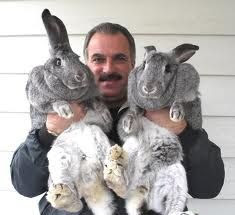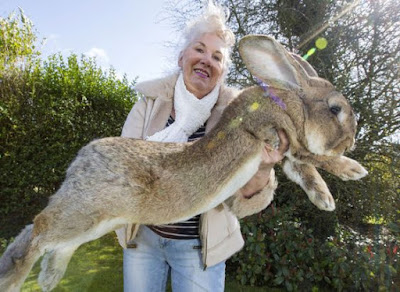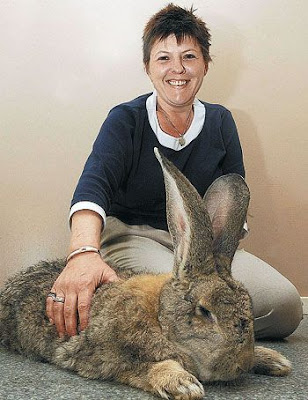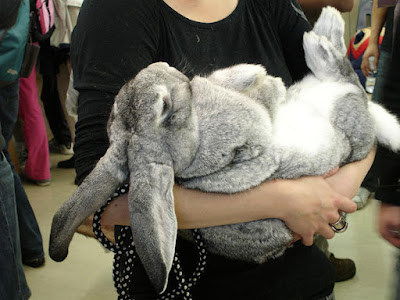Flemish Giant Rabbit: The Largest Domestic Rabbit Breed
Are all Rabbits small in size? The misconception in certain countries that Rabbits are mostly petite could be largely derived from dwarf breeds that are available for sale at Pet stores. Better known to Rabbit fanciers, giant Rabbit breeds have been around for many years before dwarf breeds. Exploring giant Rabbit breeds has led us to the Flemish Giant, the first of giant domestic Rabbit breeds.
 |
| Source |
Related:
The Flemish Giant Rabbit
Flemish Giant Rabbits are native to Flanders, Belgium close to the 16th century. Believed to be bred from even earlier and larger Rabbits such as the Steenkonijn (translated to mean Stone Rabbit, in relation to their weight and size). The earliest record of a Flemish Giant Rabbit dates as far back as 1860, where most large Rabbits were bred only for meat and fur. The official standards for Flemish Giant Rabbits were only set in 1893.
Fun Fact #1 Did you know, the Flemish Giant Rabbit breed is none other than the ancestral breed of many large Rabbits like the French Lop?
 |
| Source |
Flemish Giant Rabbit Appearance
Features — The term Giant is no joke, we are speaking of the world's largest domestic breed of Rabbit after all. The Flemish Giant has a long body with strong and wide hindquarters, coupled with tall, erect ears. Males tend to have larger heads than Females, as with most Rabbit breeds, Females are known to develop a dewlap.
Size — The average weight of a Flemish Giant ranges from 9 to 10 kgs, with an average length of a fully grown adult to be up to 76.2 cm!
 |
| Source |
Fun Fact #2 The record holder for longest Rabbit
amongst all Rabbit breeds belongs to a Flemish Giant? This record stands at 81
cm— that’s already larger than a small Dog!
 |
| Source |
Grooming A Flemish Giant
Rabbits are fastidious creatures by nature. The short, roll-back variety of coat on a Flemish Giant provides further ease in maintenance. A weekly home-grooming with a soft bristled brush kees their coats clean and smooth— carefully going through areas that your Bun may have difficulties cleaning themselves i.e. Ears, Eyes, Nails, Rears and underneath Dewlaps.
 |
| Source |
If you are unsure of how to perform these tasks, approach a trusted Groomer and Veterinarian for professional help!
Flemish Giant Rabbit Personality
Don't be intimidated by the sheer size of a Flemish Giant Rabbit. Very fondly nicknamed The Gentle Giant, Flemish Giant Rabbits are gentle, docile, friendly and affectionate. Due to their size, they may not be as jumpy as smaller breeds, but you can expect a Flemish Giant to be your cozy home companion, having a good lounging session close by your side. Some owners also enjoy donning a harness on their Flemish Giants and head out for a walk on a cool day.
 |
| Source |
Rabbit Housing And Feed
Hygiene — It is extremely important to keep your Rabbits home clean. A Regular change of food, water, bedding and litter is of utmost importance. Clean out their litter trays daily, and swap out soiled bedding with clean ones— you don’t want your bunnies sitting in their own stool and urine, this leads up to serious and painful infections.
Litter — If you chose wire flooring, make sure you have a covered/solid flooring spot large enough for the bunnies to rest their feet. If you have a solid flooring cage or living space, ensure your bunnies are litter trained, you can do so by introducing a litter pan— filled with litter (i.e. wood based pellets). Use feeding hay to entice them.
Fun Fact #3 Rabbits are known to eat their first batch of softer fecal matter because they are still packed with nutritional goodness!
Feed — A larger Rabbit consumes a larger amount of food. Hay has multiple uses, it is also an important, staple food source for rabbits. Invest in quality hay to provide your Rabbits with much required fiber, aside from food pellets and greens. Note to only introduce greens to rabbits above 8 weeks of age. Fruits can also be given in tiny proportions as an occasional snack or treat.
Litter — If you chose wire flooring, make sure you have a covered/solid flooring spot large enough for the bunnies to rest their feet. If you have a solid flooring cage or living space, ensure your bunnies are litter trained, you can do so by introducing a litter pan— filled with litter (i.e. wood based pellets). Use feeding hay to entice them.
Fun Fact #3 Rabbits are known to eat their first batch of softer fecal matter because they are still packed with nutritional goodness!
Feed — A larger Rabbit consumes a larger amount of food. Hay has multiple uses, it is also an important, staple food source for rabbits. Invest in quality hay to provide your Rabbits with much required fiber, aside from food pellets and greens. Note to only introduce greens to rabbits above 8 weeks of age. Fruits can also be given in tiny proportions as an occasional snack or treat.
Bedding & Toys — A good, thick bedding of hay is recommended, for it has been said that Rabbit feet are prone to develop sores from maneuvering around the cage for too long. Always ensure that the bedding and litter trays are clear of fecal waste that are hard.
Avoid Pine and Cedar wood bedding, for they cause respiratory problems for small Pets and animals. Provide ample space so your Flemish Giant Rabbit can move about and explore on their own time. Additionally, a nice hiding spot could work as a shade and sleeping area, away from drafts. Wooden chew toys are handy to prevent their teeth from getting overgrown.
Avoid Pine and Cedar wood bedding, for they cause respiratory problems for small Pets and animals. Provide ample space so your Flemish Giant Rabbit can move about and explore on their own time. Additionally, a nice hiding spot could work as a shade and sleeping area, away from drafts. Wooden chew toys are handy to prevent their teeth from getting overgrown.
You might also be interested in:
Your Stories Can Be Heard Too
Do YOU own an English Lop? Your voices are important to us and the Pets community! Our readers are encouraged to share their Pet-related reviews of a place and its services, experiences, even lifestyle tips and tricks to better our Pets lives, on our platform, one paw at a time. Be a part of an educational and informative Pets community because at ThePetsDialogue, your voices could make a huge difference.
Do YOU own an English Lop? Your voices are important to us and the Pets community! Our readers are encouraged to share their Pet-related reviews of a place and its services, experiences, even lifestyle tips and tricks to better our Pets lives, on our platform, one paw at a time. Be a part of an educational and informative Pets community because at ThePetsDialogue, your voices could make a huge difference.
Our website is a work in progress, however, if you did find our articles interesting please do feel free to share! For more Pet care tips and other Pet-related articles, head to www.thepetsdialogue.com ☺
Our website is a work in progress, however, if you did find our articles interesting please do feel free to share! For more Pet care tips and other Pet-related articles, head to www.thepetsdialogue.com ☺





I was reading some of your content on this website and I conceive this internet site is really informative ! Keep on putting up. Best litter box for large cats
ReplyDelete